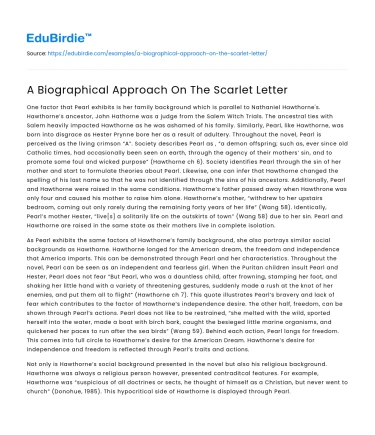One factor that Pearl exhibits is her family background which is parallel to Nathaniel Hawthorne's. Hawthorne’s ancestor, John Hathorne was a judge from the Salem Witch Trials. The ancestral ties with Salem heavily impacted Hawthorne as he was ashamed of his family. Similarly, Pearl, like Hawthorne, was born into disgrace as Hester Prynne bore her as a result of adultery. Throughout the novel, Pearl is perceived as the living crimson “A”. Society describes Pearl as , “a demon offspring; such as, ever since old Catholic times, had occasionally been seen on earth, through the agency of their mothers’ sin, and to promote some foul and wicked purpose” (Hawthorne ch 6). Society identifies Pearl through the sin of her mother and start to formulate theories about Pearl. Likewise, one can infer that Hawthorne changed the spelling of his last name so that he was not identified through the sins of his ancestors. Additionally, Pearl and Hawthorne were raised in the same conditions. Hawthorne’s father passed away when Hawthrone was only four and caused his mother to raise him alone. Hawthorne’s mother, “withdrew to her upstairs bedroom, coming out only rarely during the remaining forty years of her life” (Wang 58). Identically, Pearl’s mother Hester, “live[s] a solitarily life on the outskirts of town” (Wang 58) due to her sin. Pearl and Hawthorne are raised in the same state as their mothers live in complete isolation.
As Pearl exhibits the same factors of Hawthorne’s family background, she also portrays similar social backgrounds as Hawthorne. Hawthorne longed for the American dream, the freedom and independence that America imparts. This can be demonstrated through Pearl and her characteristics. Throughout the novel, Pearl can be seen as an independent and fearless girl. When the Puritan children insult Pearl and Hester, Pearl does not fear “But Pearl, who was a dauntless child, after frowning, stamping her foot, and shaking her little hand with a variety of threatening gestures, suddenly made a rush at the knot of her enemies, and put them all to flight” (Hawthorne ch 7). This quote illustrates Pearl’s bravery and lack of fear which contributes to the factor of Hawthorne’s independence desire. The other half, freedom, can be shown through Pearl’s actions. Pearl does not like to be restrained, “she melted with the wild, sported herself into the water, made a boat with birch bark, caught the besieged little marine organisms, and quickened her paces to run after the sea birds” (Wang 59). Behind each action, Pearl longs for freedom. This comes into full circle to Hawthorne’s desire for the American Dream. Hawthorne’s desire for independence and freedom is reflected through Pearl’s traits and actions.
Save your time!
We can take care of your essay
- Proper editing and formatting
- Free revision, title page, and bibliography
- Flexible prices and money-back guarantee
Not only is Hawthorne’s social background presented in the novel but also his religious background. Hawthorne was always a religious person however, presented contraditcal features. For example, Hawthorne was “suspicious of all doctrines or sects, he thought of himself as a Christian, but never went to church” (Donohue, 1985). This hypocritical side of Hawthorne is displayed through Pearl. Similar to Hawthorne, Pearl is hypocritical towards Purtian beliefs. Throughout the novel, Pearl can be seen breaking Puritan standards.
Work Cited
- Donohue, C. (1985). The New England Source of The Scarlet Letter. In S. Bradley et al. (Eds.), The Scarlet Letter: AN Authoritative Text Backgrounds and Sources Criticism. New York: W.W.Norton and Company.






 Stuck on your essay?
Stuck on your essay?

